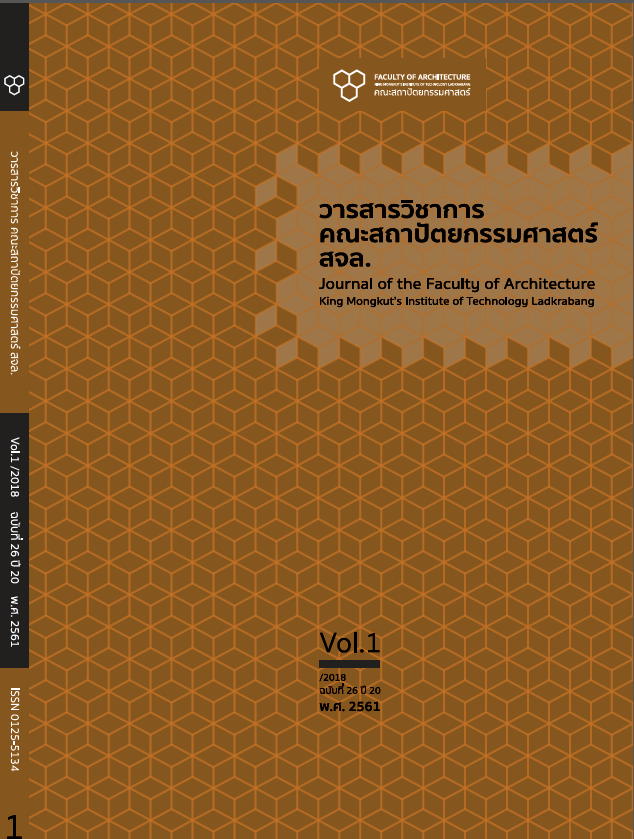การวิเคราะห์เอกลักษณ์ไทยด้วยหลักความสัมพันธ์ทางวัฒนธรรมในความคิดเห็นของนักท่องเที่ยวต่างชาติ, An Analysis of Thai Identity through Principles of Cultural Relations in Foreign Tourists’ Opinion
Main Article Content
Abstract
บทคัดย่อ
งานวิจัยนี้มีวัตถุประสงค์คือนำเสนอผลของการวิเคราะห์เอกลักษณ์ไทยที่สื่อถึงประเทศไทยในความคิดเห็นของนักท่องเที่ยวต่างชาติ เพื่อให้นักออกแบบใช้ผลวิจัยในการออกแบบผลิตภัณฑ์แก่นักท่องเที่ยวต่างชาติ โดยเก็บรวบรวมข้อมูลกับกลุ่มตัวอย่างคือนักท่องเที่ยวต่างชาติจำนวน 400 คน อำเภอเมืองพัทยา จังหวัดชลบุรี ด้วยแบบสอบถาม ตัวแปรต้นปัจจัยส่วนบุคคลและความคิดเห็น ตัวแปรตามคือเอกลักษณ์ไทยที่สื่อถึงประเทศไทยในความคิดเห็นของชาวนักท่องเที่ยวต่างชาติ วิเคราะห์ข้อมูลด้วยค่าความถี่และค่าร้อยละ จำแนกและลงรหัสจัดหมวดหมู่ข้อมูลตามหลักความสัมพันธ์ทางวัฒนธรรม 3 หมวด คือ วัฒนธรรมทางความคิด วัฒนธรรมทางพฤติกรรมและการกระทำ และวัฒนธรรมทางวัตถุ ผลคือเอกลักษณ์ไทยที่สามารถสื่อถึงประเทศไทยจำแนกได้ดังนี้ อันดับที่ 1 ร้อยละ 71 คือ หมวดธรรมชาติและสภาพแวดล้อมพบ 11 ตัวแทนย่อย อันดับที่ 2 ร้อยละ 34.50 คือ หมวดวัฒนธรรมทางด้านวัตถุพบ 8 ตัวแทนย่อย อันดับที่ 3 ร้อยละ 25.50 คือ หมวดวัฒนธรรมทางพฤติกรรมและการกระทำพบ 6 ตัวแทนย่อย อันดับที่ 4 ร้อยละ 18.25 คือ หมวดอื่นที่ไม่สามารถจัดเข้าหมวดหมู่ได้พบ 6 ตัวแทนย่อย และอันดับที่ 5 ร้อยละ 8.50 คือ หมวดวัฒนธรรมทางความคิดพบ 2 ตัวแทนย่อย นักออกแบบผลิตภัณฑ์สามารถใช้ผลการวิจัยนี้ด้วยหลักการสัญศาสตร์ของเพียร์ซคือ การใช้รูปสัญญะแบบเครื่องหมายภาพเหมือน แบบเครื่องหมายภาพดรรชนี และแบบเครื่องหมายภาพสัญลักษณ์ในการออกแบบ
คำสำคัญ: เอกลักษณ์ไทย นักท่องเที่ยวต่างชาติ ความคิดเห็น
Abstract
This research objective is to analyze the Thai Identity representing Thainess in foreign tourists’ opinions for designer to use research results in designing products for foreign tourists by collecting data from 400
foreign tourists at Pattaya City Chonburi province with questionnaires. Independent variables are personal factors and opinions. Dependent variables are Thai Identity in foreign tourists’ opinions. The dsta were analyzed from percentage and frequency. The results bring to classified and categorized the information according to 3 cultural related principles: Culture of Ideas (THINKING), Culture of Norms (DOING) and Culture of Materials (HAVING). The results showed that signs of Thai identity could be classified as follows. First group with 71 percent is expressed by nature and environment found with 11 sub-representatives. Second group with 34.50 percent is conveyed by culture of materials found with 8 sub-representatives. Third group with 25.50 percent is expressed by culture of norms found with 6 sub-representatives. Fourth group with 18.25 percent is conveyed by other categories which could not be classified found with 6 sub-representatives. Moreover, fifth group with 8.50 percent is expressed by culture of ideas found with 2 sub-representatives. Product designer can use the result data based on Peirce’s Semiotic principle including use of signifier: iconic sign, indexical sign and symbolic sign in design.
Keyword: Thai Identity, Foreign Tourists, Opinion
Article Details
This work is licensed under a Creative Commons Attribution-NonCommercial-ShareAlike 4.0 International License.
Copyright Transfer Statement
The copyright of this article is transferred to Journal of The Faculty of Architecture King Mongkut's Institute of Technology Ladkrabang with effect if and when the article is accepted for publication. The copyright transfer covers the exclusive right to reproduce and distribute the article, including reprints, translations, photographic reproductions, electronic form (offline, online) or any other reproductions of similar nature.
The author warrants that this contribution is original and that he/she has full power to make this grant. The author signs for and accepts responsibility for releasing this material on behalf of any and all co-authors.
References
ไชยรัตน์ เจริญสินโอฬาร. (2545). สัญวิทยา โครงสร้างนิยม หลังโครงสร้างนิยมกับการศึกษารัฐศาสตร์. กรุงเทพฯ: วิภาษา.
นงภัส ศรีสงคราม. (2547). การสื่อสารทางวัฒนธรรมด้านอัตลักษณ์และสัญญะวิทยาของชาวไทยโซ่ง ในหมู่บ้านดอนเตาอิฐ จังหวัดกาญจนบุรี (วิทยานิพนธ์ปริญญามหาบัณฑิต มหาวิทยาลัยธุรกิจบัณฑิต).
บุญชม ศรีสะอาด. (2538). หลักการวิจัยเบื้องต้น. กรุงเทพฯ: สุวีริยาสาสน์.
มหาวิทยาลัยเกษตรศาสตร์. (2561). ความหมายสิ่งแวดล้อม. เข้าถึงได้จาก https://web.ku.ac.th/schoolnet/snet6/envi1/envi1-1.htm.
วิวัฒน์ เตมีพันธ์. (20 สิงหาคม 2555). [สัมภาษณ์โดย สุภารีย์ เถาว์วงศ์ษา. ความสัมพันธ์รากฐานทางวัฒนธรรม.สถาบันเทคโนโลยีพระจอมเกล้าเจ้าคุณทหารลาดกระบัง.
มิเชล, โอชอนเนสซี. และเจน, แสตดเลอร์. (2533). สัญญศาสตร์ การศึกษาเรื่องเครื่องหมาย. (สมเกียรติ ตั้งนโม, แปล.).เข้าถึงได้จาก https://www.khum.net/news-read/916880
สุภารีย์ เถาว์วงศ์ษา. (2560). พฤติกรรมการซื้อสินค้าของที่ระลึกของนักท่องเที่ยวต่างชาติเพื่อการออกแบบของที่ระลึก. ในการประชุมวิชาการระดับชาติและนานาชาติสหวิทยาการสร้างสรรค์เพื่อการพัฒนาที่ยั่งยืนครั้งที่ 2
(หน้า A1-A16). กรุงเทพฯ: ศูนย์มานุษยวิทยาสิรินธร (องค์การมหาชน).
สำนักงานราชบัณฑิตยสภา. (2558). ความหมายของอัตลักษณ์และเอกลักษณ์. เข้าถึงได้จาก https://www.royin.go.th/dictionary/
Crow, D. (2003). Introducing Semiotics. Switzerland: AVA Publishing SA.
Cobley, P. and Jansz, L. (1999). Introducing Semiotics. United Kingdom: Icon Books.
Yamane, T. (1973). Statistics: An introductory Analysis. 3nd ed. New York: Harper and Row.


